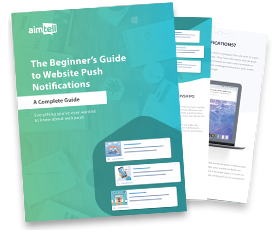Web push notifications are still a relatively new concept for people, and because of that a really common question we get here at Aimtell is asking about the difference between web push notifications and email. We get it. Email is an established platform that everyone has experience using. If there are no real differences between web push and email, why take the time to learn a new system?
Here’s the thing- there are plenty of differences between email and web push notifications. And as you’ll see, the differences are what make web push so great. To best explain things, we decided to created this chart to highlight the main differences between email and web push notifications.
| Web Push Notifications | Email |
| Registration | One click- user hits ‘allow’ and they are instantly subscribed. No forms required. | Longer opt-in process. User has to type in email and often personal info (ie first and last name), receive confirmation email, then click link in email to confirm subscription. |
| Delivery | Instant delivery- even if a user is not at your website, the notification will be delivered. Supported on both desktop computers and mobile devices. | Delivered to inbox of the email address a user provided. It is up to the person to check the given email inbox, navigate to the email and open it to view the contents of the message. Supported on both desktop computers and mobile devices. |
| Creation | Very easy- follow a few short steps and you have a campaign created. Write a few sentences, pick an image, provide a link. | Numerous steps. First have to create the copy for the body of the message, come up with an appropriate subject line, select images, create the layout for the email, check the campaign looks good on all device types, and then schedule. |
| Visibility | High visibility. The notification is shown instantly and usually does not have to compete with any other messages. | Low visibility. Message is mixed among all other emails a person receives and may go unnoticed or be deleted without being seen. |
| Spam | There are no spam filters to worry about. You can’t get a “fake” subscriber and notifications can’t get caught in spam filters. | Huge concern. If an email isn’t set up correctly, it may appear to a user as spam. An email provider may make that decision for you and place your message in a spam folder and the user will never even see your message. |
Hopefully this chart helps to clarify any confusion you might have between the two tools. From a user first opting in, to creation, delivery, reception, and more, web push notifications and email differ in just about every regard.
Email marketing has been around for a long time, and at one point it was an incredibly effective tool. While it is by no means obsolete, it has lost a lot of its initial effectiveness, and is only continuing to do so. Web push notifications offer brands a new way of interacting and communicating with their subscribers. With shorter messages, instant deliverability, a quicker opt-in process, easy creation, and no possibility of ending up in spam, it is easy to see the clear differences between email and web push notifications.
For a more detailed look at web push, check out our Beginner’s Guide.
If you wish to get started using Aimtell, click here.
Tags:
difference between email and web push notifications*, digital marketing, ecommerce, email, web push notifications.

























